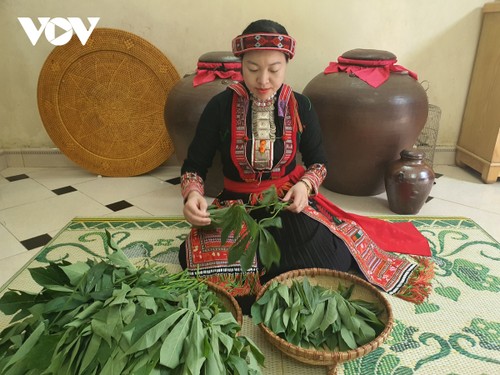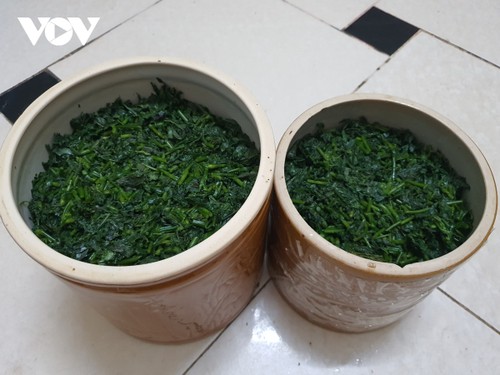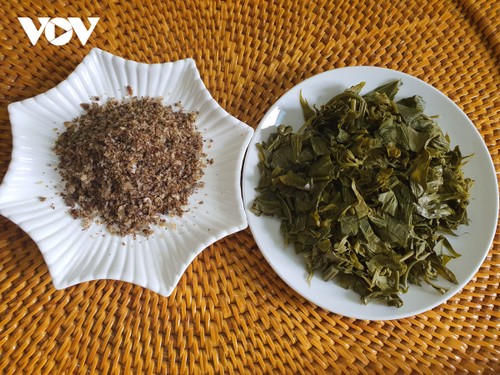When cassava sprouts and grows new leaves, Red Dao people pick the young parts of the edible plant to make mờ sán sui, which means pickled cassava leaves. They only pickle the sprouts from indigenous green and red cassava varieties, and never use high-yielding cassava because it easily causes poisoning.
 A Red Dao girl prepares cassava leaves to make pickled mờ sán sui.(Photo: VOV) A Red Dao girl prepares cassava leaves to make pickled mờ sán sui.(Photo: VOV) |
It’s a plain dish, so in order to create a delicious flavor and eye-catching color, they must go through careful initial processing. Normally, they pick the top of the sprout with one or two leaves, because old leaves are fibrous and hard.
After being cut, the sprouts are cleaned with water, chopped into about 2 cm pieces, and softly washed in salty water. They rinse, crush, and squeeze the cassava sprouts carefully as gently as possible to avoid crumbling them which will make the final dish less beautiful.
Ban Thi Duc of Khe Van hamlet, Van Yen district, said they rinse cassava leaves in salty water to remove bitter resin and soften the leaves before pickling them.
 Cassave leaves are pickled in vases. (Photo: VOV) Cassave leaves are pickled in vases. (Photo: VOV) |
“To give mờ sán sui a yellow color and make it tasty, we must rinse the cassava leaves in salty water and squeeze them. The more yellow the pickles, the more delicious it is,” said Duc.
Pickling is the most important step. They boil water, let it cool down to about 30 degrees Celsius, and add some salt to it. Fresh water should not be used because the pickles will turn pungently sour. The cassava leaves are put in a vase and soaked in salt water. They put a plate in the vase to press the leaves and cover the vase’s mouth with banana leaves.
About a week later, they check to see if the pickles have a nice yellow color and good smell. Then it can be used for cooking other dishes.
Mờ sán sui pickles are suitable for cooking fish soup and fried with fish, egg, and meat. Mờ sán sui fried with spring fish is a special dish of the Red Dao. Spring fish is prepared and seasoned with salt before being grilled over charcoal fire until it turns yellow and produces a good smell. The grilled fish is then minced and fried with the pickled cassava leaves.
 Grilled fish is minced before being fried with mờ sán sui. (Photo: VOV) Grilled fish is minced before being fried with mờ sán sui. (Photo: VOV) |
Ly Thi Mui of Sam Tren hamlet said, “Grilled fish is minced and fried with pork fat. Mờ sán sui is squeezed to dry. Then we fry them together for about 10 minutes. We add some seasoning powder to balance the taste for a less fishy smell. Mờ sán sui tastes the best with fish.”
Dishes made with mờ sán sui pickles have a sour and fatty taste which is best with steamed glutinous rice or plain rice.
“Whenever I have a business trip to the Red Dao community, I always buy pickled cassava leaves. They’re delicious for fish soup. There is no more fishy smell. I love the traditional food of the Red Dao,” said Nguyen Phuong Linh of Yen Bai city.
Visitors to Red Dao hamlets are often served mờ sán sui to better understand the local culture and cuisine.